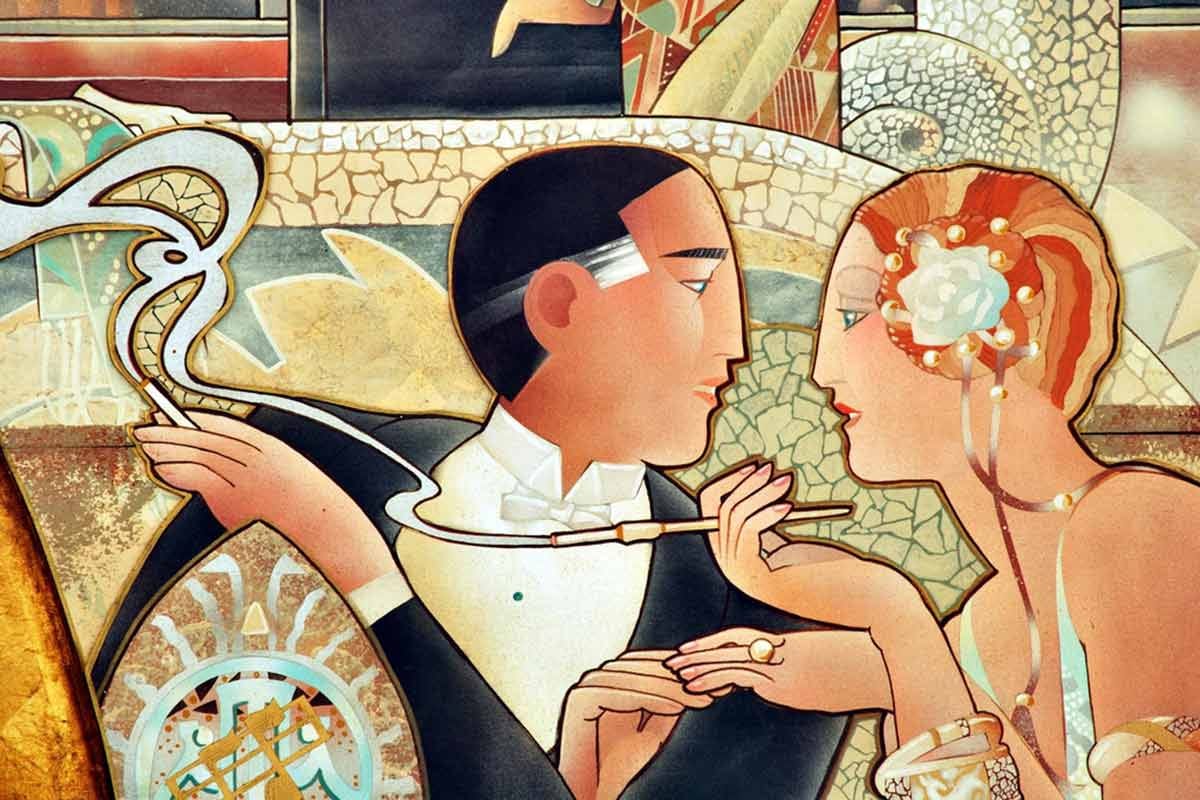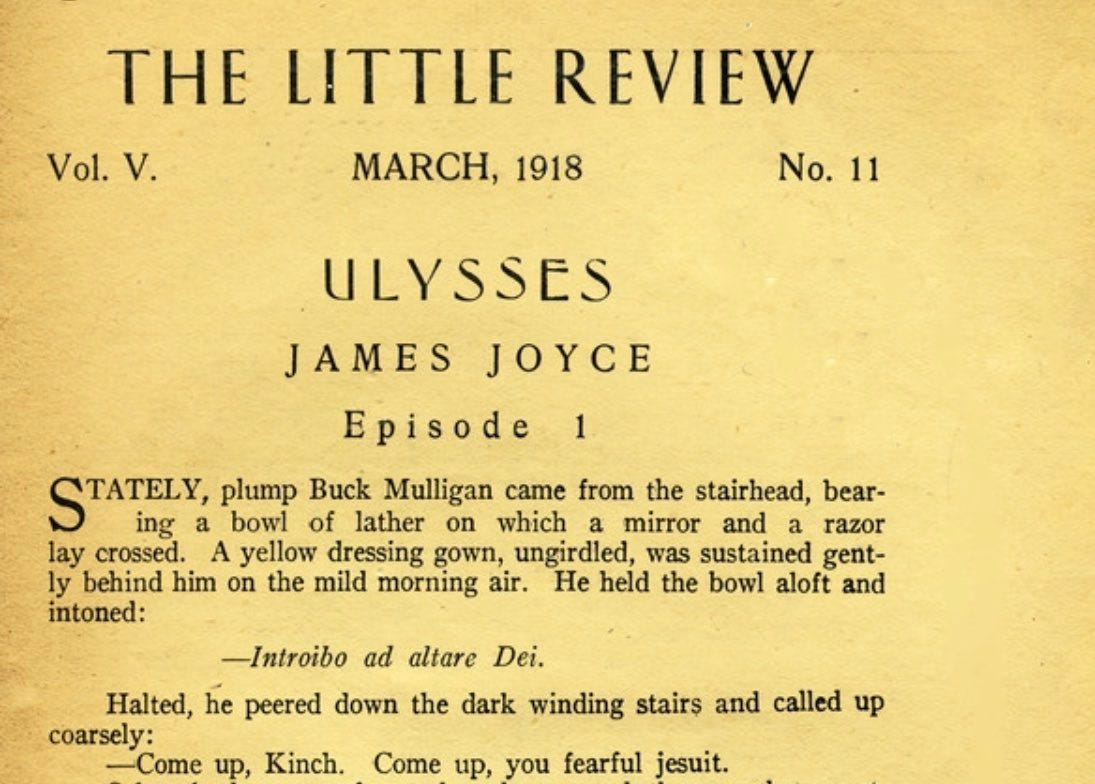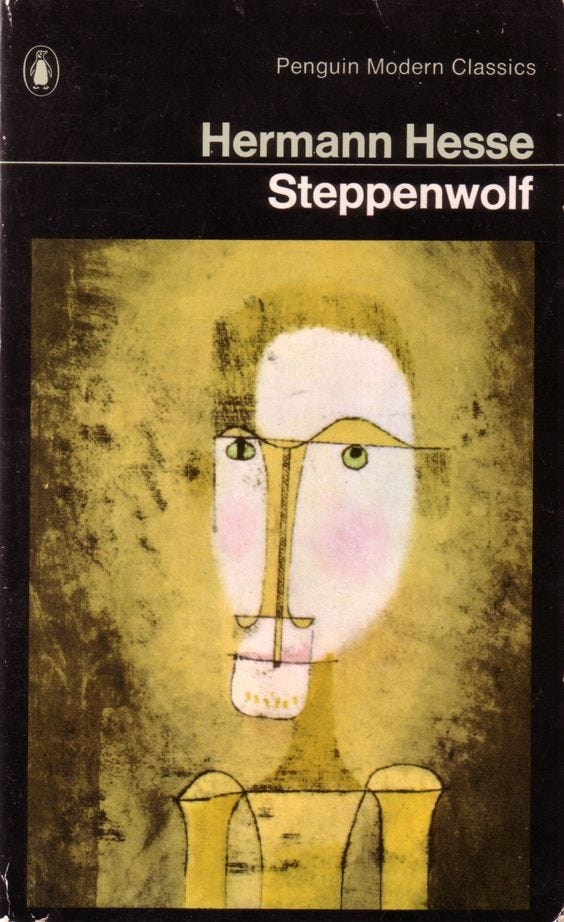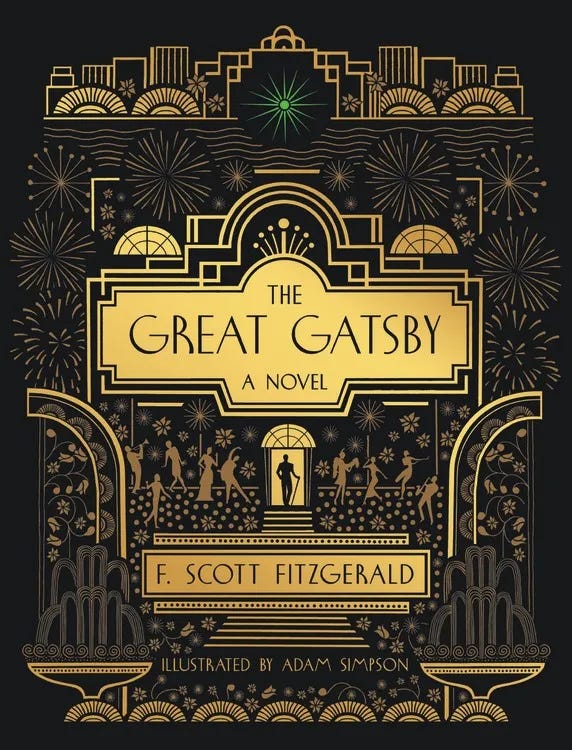[Note: Put cursor over footnote for pop-up.]
The boundaries between eras of social history are often hard to see except in retrospect. But the break between writers who came of age after World War I and the pre-war literary establishment (Joseph Conrad, John Galsworthy, Arnold Bennett, H. G. Wells, Willa Cather, Henry James, Edith Wharton, Jack London, G. K. Chesterton and many others) was dramatic—more sea change than evolution. Gertrude Stein famously called the ex-pat American writers in Paris a "lost generation."
The horrors of the Great War and the Russian Revolution had ruptured world history; modernism had swept through the art world after the Armory Show of 1913; there was a rapid shift in attitudes and social mores; in America, the onset of Prohibition spurred the growth organized crime; financial speculation bloomed under laissez-faire Republican administrations . . . and so on, many factors coalescing to accelerate change.
Pre-war writers continued to publish in the Twenties, but there was a powerful generational shift, younger writers driven by Ezra Pound's mandate to "make it new."
Twelve Big Books of the 1920s:
As I Lay Dying, William Faulkner (1930) 1
The Sound and the Fury, William Faulkner (1929)
A Farewell to Arms, Ernest Hemingway (1929)
A Room of One's Own [essay], Virginia Woolf (1928)
To the Lighthouse, Virginia Woolf (1927)
The Sun Also Rises, Ernest Hemingway (1926)
Manhattan Transfer, John Dos Passos (1925) 2
An American Tragedy, Theodore Dreiser (1925) 3
Mrs. Dalloway, Virginia Woolf (1925)
The Great Gatsby, F. Scott Fitzgerald (1925) 4
The Magic Mountain, Thomas Mann (1924) 5
Ulysses, James Joyce (1922) 6
The Midwest:
Babbitt (1922), Arrowsmith (1925), Elmer Gantry (1927), and Dodsworth (1929), Sinclair Lewis
A Lantern in Her Hand, Bess Streeter Aldrich (1928) 7
Giants in the Earth, O. E. Rölvaag (first American edition (1927)
Alice Adams, Booth Tarkington (1921) 8
The Harlem Renaissance:
Passing, Nella Larsen (1929)
Plum Bun: A Novel Without a Moral, Jessie Redmon Fauset (1928) 9 10
Cane, Jean Toomer (1923) 11
Books Originally in Other Languages:
Fear, Gabriel Chevallier (1930) France
Civilization and Its Discontents [psychology], Sigmund Freud (1930) Austria
Insatiability, Stanisław Ignacy Witkiewicz (1930) Poland
Berlin Alexanderplatz, Alfred Döblin (1929) Germany
All Quiet on the Western Front, Erich Maria Remarque (1929) Germany
Nadja, André Breton (1928) France 12
The Twelve Chairs, Ilf & Petrov (1928) USSR
Steppenwolf, Hermann Hesse (1927) Switzerland (German)
Thérèse Desqueyroux, François Mauriac (1927) France 13
In Search of Lost Time [vol 3-7], Marcel Proust (1921-1927) France
Beauty on Earth, Charles-Ferdinand Ramuz (1927) Switzerland (French)
Twenty-Four Hours in the Life of a Woman [novella], Stefan Zweig (1927) Austria
The Castle, Franz Kafka (1926) Czech
The Trial, Franz Kafka (1925) Czech
We, Yevgeny Zamyatin (1924) USSR 14
The Confessions of Zeno, Italo Svevo (1923) Italy/Austro-Hungary 15
Siddhartha, Hermann Hesse (1922) Switzerland (German)
An alternate list:
Laughing Boy, Oliver La Farge (1930) 16
The Well of Loneliness, Radclyffe Hall (1929) 17
Flowering Judas [stories], Katherine Anne Porter (1929) 18
Living, Henry Green, (1929)
Red Harvest, Dashiell Hammett, (1929)
A High Wind in Jamaica, Richard Hughes (1929) 19
Look Homeward, Angel, Thomas Wolfe (1929)
Point Counter Point, Aldous Huxley (1928)
Death Comes for the Archbishop Willa Cather, (1927)
Bridge of San Luis Rey, Thornton Wilder (1927) 20
Lolly Willowes, Sylvia Townsend Warner (1926) 21
The Cubical City, Janet Flanner (1926) 22
Sorrell and Son, Warwick Deeping (1925)
Barren Ground, Ellen Glasgow (1925)
Gentlemen Prefer Blondes, Anita Loos (1925) 23
The Painted Veil, W. Somerset Maugham (1925)
The Informer, Liam O'Flaherty (1925) 24
So-Big Edna Ferber (1924) 25
The Crowded Street, Winifred Holtby (1924)
A Passage to India, E. M. Forster (1924)
The Enchanted April, Elizabeth von Arnim (1922)
The Garden Party, Katherine Mansfield [stories] (1922) 26
A ten-book challenge:
If you have gaps in your reading of the “Big List—fill in at least two.
Read one of the Harlem Renaissance titles and one of the Midwest titles [or equivalent titles of your choosing].
Read (at least) three of the international titles.
Read (at least) three from the alt-list.
As I Lay Dying: Another of my long-time favorites. Faulkner’s prose was the antithesis of Hemingway’s—writer Ford Maddox Ford once said that each of Hemingway’s words were like “pebbles fetched fresh from a brook.” Whereas Faulkner’s style was Faulknerian—lush descriptions, long sinuous sentences, a piling on of words and high-toned rhetoric, the irrepressible past boiling out of it. "The past is never dead,” he famously wrote (in Requiem for a Nun), “it's not even past." Most of his stories take place in the fictive Yoknapatawpha County, Mississippi. As I Lay Dying is leaner and stranger than many of his major works—Light in August (1932) or Absalom, Absalom! (1936), for example.
The dying matriarch of the Bundren family has one simple wish: to be buried with her own people. Bad luck for her: they’re on the other side of the river, and the river’s swollen with flood water. What unfolds is a tale of heroic ineptitude, told by a rotating cast of first-person speakers—world-class cheapskate, Anse Bundren, his sons Darl, Cash, and Vardaman, daughter Dewey Dell, and several others. Not to be missed.
Dos Passos: The USA Trilogy [The 42nd Parallel (1930), 1919 (1932), The Big Money (1936) is usually considered Dos Passos's masterpiece. But I loved Manhattan Transfer. Sometimes you remember a book not for its story, but for its feel, its ambiance, for how it sounds . . . for the writing. Again and again, in the margins I scribbled things like: Everywhere you look, great sentences . . . and Wow and !!!. Here’s a taste:
A car whirred across the bridge making the girders rattle and the spiderwork of cables thrum like a shaken banjo.
She stood in the middle of the street waiting for the uptown car. An occasional taxi whizzed by her. From the river on the warm wind came the long moan of a steamboat whistle. In the pit inside her thousands of gnomes where building tall brittle glittering towers.
“Say Anna,” says a broadhipped blond girl . . . “did ye see that sap was dancin wid me? . . . He says to me the sap he says See you later an I says to him the sap I says see yez in hell foist . . . an then he says, Goily he says . . . "
Theodore Dreiser: Having read the turgid Sister Carrie (1900), I could never bring myself to read An American Tragedy (a crime story based on a real murder case); nonetheless it's a famous novel.
Gatsby has always seemed in a class by itself, a perfect construction. I suppose that’s open to debate, but what I want to mention now: In his small handbook, Writing in General, The Short Story in Particular, Rust Hills [fiction editor of Esquire back when Esquire ran quality fiction] used it to explain “Hills’ Law,” which states that in a first-person novel, the first-person/narrator is the character the book is about—even when that seems not to be the case. When you run through the characters in Gatsby, everyone is essentially unchanged at the end [except Gatsby, who’d dead, but that doesn’t count] . . . the only one who’s been altered by living through the events is Nick, who decides he’s seen enough of these privileged East Coast people he’s been among and goes home to the Midwest.
Thomas Mann: Based on Mann’s own time in TB sanitarium. Originally in German (1924), the English translation appearing in 1927. All the other translated works in today’s post are in a separate list below.
[Footnote on a footnote: I stumbled into another TB sanitarium novel a while ago, not widely known: The Rack, A. E. Ellis, 1958. I recommend.
James Joyce: Stately, plump Buck Mulligan . . . This is a wonderfully rewarding read, but you need a good guide to accompany you. Some chapters are easy sailing, but many need some background—their design scheme, the parallels/divergences to The Odyssey, and so on. The first link below is an online resource, the other an Amazon link (but don’t buy it from Amazon). If you bounced off this book when you were younger (as I did a couple of times), go back and try again.
https://www.ulyssesguide.com/
https://www.amazon.com/Guide-James-Joyces-Ulysses/dp/142144349X
Aldrich: First published in 1928, A Lantern in Her Hand has outlasted literary fashions to touch generations of readers. In this classic story of a pioneer woman, Bess Streeter Aldrich modeled protagonist Abbie Deal on her own mother, who in 1854 had traveled by covered wagon to the Midwest.
Tarkington was given the 1922 Pulitzer for this work. He was enormously popular in his day. His other major novel is The Magnificent Ambersons (1918); he's also remembered for his Penrod books—the life and times of an eleven-year-old boy in the pre-WWI Midwest.
Plum Bun: As literary editor of The Crisis during the 1920s, Fauset promoted the work of other members of the Harlem Renaissance—Langston Hughes, Countee Cullen, Claude McKay, Jean Toomer, et al.
Cane: Innovative classic of the Harlem Renaissance, an assemblage of narrative vignettes and lyric poetry. “I love it passionately; could not possibly live without it.” —Alice Walker.
Nadja: Cult classic of French Surrealist movement, semi-autobiographical. #50 on Le Monde’s 100 Novels of the 20th Century.
Mauriac: French novelist, dramatist, critic, poet, and journalist, Nobel Prize in Literature (1952). Thérèse Desqueyroux is his best-known work.
We: Early sci-fi, a cult classic. Ursula K. Le Guin once called this "the best single work of science fiction yet written."
Italo Svevo: Pen name of Aron Hector Schmit, from Trieste where James Joyce tutored him in English. Joyce was instrumental in having Svevo's novel translated into French, then published in Paris, where it became much more widely known. It's said that Svevo was a model for Leopold Bloom in Joyce's Ulysses.
Laughing Boy: "Set in 1915, about the struggles of the Navajo Nation to reconcile their culture with that of the Anglos. Winner of the 1930 Pulitzer Prize."
https://en.wikipedia.org/wiki/Laughing_Boy_(novel)
The Well of Loneliness: Radclyffe Hall: https://en.wikipedia.org/wiki/The_Well_of_Loneliness
Katherine Anne Porter: Almost died in the 1918 Spanish Flu epidemic, which became the basis of her Pale Horse, Pale Rider: Three Short Novels (1939). The Collected Stories (1965) earned a Pulitzer in Fiction. Flowering Judas is a collection of her earliest stories. She wrote one novel, the blockbuster, Ship of Fools (1962) [also a high-profile film of the same name, 1965].
https://en.wikipedia.org/wiki/Katherine_Anne_Porter
A High Wind in Jamaica: "This brilliant, gorgeously written, highly entertaining, and apparently light-hearted idyll quickly reveals its true nature as a powerful and profoundly disquieting meditation on the meaning of loyalty and betrayal, innocence and corruption, truth and deception." —Francine Prose
https://en.wikipedia.org/wiki/A_High_Wind_in_Jamaica_(novel)
Thornton Wilder: Wilder was a prolific playwright—The Skin of Our Teeth (1942) and Our Town (1938) both won Pulitzers. The Bridge of San Luis Rey won a Pulitzer in Fiction.
[Side note: Ann Patchett's newest novel, Tom Lake (2023), is suffused with performances of Our Town. I recommend it.]
Sylvia Townsend Warner: Lolly Willowes was Warner’s first novel, a comedy of manners, the story of “a middle-aged spinster who moves to a country village to escape her controlling relative and takes up the practice of witchcraft.” Considered an early feminist classic.
Janet Flanner: The New Yorker’s Paris correspondent from 1925-1975. Highly respected journalist, covered WWII, the Nuremburg Trials, and other major European stories.
“Reading Janet Flanner’s novel, The Cubical City (1926), as a lesbian modernist novel provides insight, not only into the author’s personal turmoil around coming out, but into broader work on the lesbian identity that was evolving during the modernist period in transatlantic literature.” —Rai Peterson, “Janet Flanner’s The Cubical City and the Life She Left Behind” [https://journals.openedition.org/erea/7408 ]
Anita Loos: Actress, novelist, playwright, became the first woman screenwriter in Hollywood.
Wiki: Gentlemen Prefer Blondes: The Illuminating Diary of a Professional Lady, began as . . . short sketches published in Harper's Bazaar . . . The heroine of the stories, Lorelei Lee, was a bold, ambitious flapper . . . more concerned with collecting expensive baubles from her conquests than any marriage licenses, in addition to being a shrewd woman of loose morals and high self-esteem. She was a practical young woman who had internalized the materialism of the United States in the 1920s and equated culture with cold cash and tangible assets.”
Loos led a life in the thick of Hollywood royalty, acted in scores of early films, and was still working in the 1950s when she adapted Collette’s Gigi for film.
The Informer: Dublin, the 1920s, the aftermath of the Irish Civil War. I’d never heard of this, but dug up a copy. A story of betrayal—fairly short, gritty, almost claustrophobic sense of place, of fate.
https://en.wikipedia.org/wiki/Liam_O%27Flaherty
Edna Ferber: A member of the infamous Algonquin Roundtable—she collaborated with fellow Algonquinite, George S. Kaufman (and others) on a number of plays and musicals, including Stage Door, Dinner at Eight, and Showboat. Her novel, So Big, won the 1925 Pulitzer for Fiction. Altogether, she published several dozen novels, story collections, and nonfiction works, besides the pieces for theater. Her later novel, Giant (1952)—cattle barons and oil tycoons in Texas—became the classic film of the same name (1956) with Rock Hudson, Elizabeth Taylor, and James Dean.
Katherine Mansfield: New Zealander by birth, relocated to London by age twenty, fell in with the Bloomsbury group; bohemian, bisexual, died of TB at age 34. This collection has (besides “The Garden Party”) “Daughters of the Late Colonel,” “At the Bay,” “Miss Brill” and others. See also Bliss and Other Stories (1920).
https://thespinoff.co.nz/books/01-04-2023/the-stories-of-katherine-mansfield-ranked
[PS: If you don’t know much about the Bloomsbury set, start with this blog post:
https://www.booktherapy.io/en-us/pages/best-books-on-the-bloomsbury-group
I think we often forget the role of a writer’s cohort—the friends and fellow practitioners, the spouses and SO’s, the artists in other media, other disciplines, the editors of related mags/blogs, etc., the small press publishers, the financial enablers, and all the rest.
Though I shouldn’t be, I’m always a little surprised to learn of such groups, to be reminded that the art-makers of other times are like us—doing their work, hanging out with like-minded souls, being modern, disdaining what H. L. Mencken called the Booboisie . . . Reading about Marian (aka Mary Ann) Evans who became George Eliot, I ran into John Chapman (editor, publisher, bookseller) whose place was the nexus of a group of Victorian writers and home of the highly influential Westminster Review. See Rosemary Ashton’s, 142 Strand: A Radical Address in Victorian London (2006).







One small correction: Ursula K. Le Guin. The K for her family name (famous) and capped "Le" before "Guin." There is a story for another time.